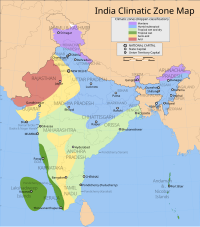Portal:India/SC Summary/SA Climate of India
| This page is currently inactive and is retained for historical reference. Either the page is no longer relevant or consensus on its purpose has become unclear. To revive discussion, seek broader input via a forum such as the village pump. |
The climate of India comprises a wide range of weather conditions across a vast geographic scale and varied topography, making generalisations difficult. Based on the Köppen system, India hosts six major climatic subtypes, ranging from arid desert in the west, alpine tundra and glaciers in the north, and humid tropical regions supporting rainforests in the southwest and the island territories. Many regions have starkly different microclimates. The nation has four seasons: winter (January and February), summer (March to May), a monsoon (rainy) season (June–September), and a post-monsoon period (October–December).
India's unique geography and geology strongly influence its climate; this is particularly true of the Himalayas in the north and the Thar Desert in the northwest. The Himalayas act as a barrier to the frigid katabatic winds flowing down from Central Asia. Thus, North India is kept warm or only mildly cooled during winter; in summer, the same phenomenon makes India relatively hot. Although the Tropic of Cancer—the boundary between the tropics and subtropics—passes through the middle of India, the whole country is considered to be tropical.
As in much of the tropics, monsoonal and other weather conditions in India are unstable: major droughts, floods, cyclones and other natural disasters are sporadic, but have killed or displaced millions. India's long-term climatic stability is further threatened by global warming. Climatic diversity in India makes the analysis of these issues complex. (more...)

